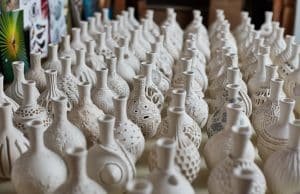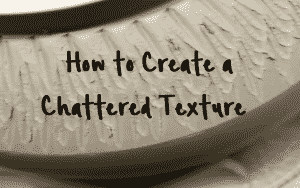If you ever plan on joining two pieces of clay together (and we’re sure that you do!), you’ll need to know how to make slip. Slip is the glue that allows us to attach handles to pots, limbs to sculptures, and coils to pinch pots. Without the use of slip, you will not have a strong bond at your connection points, making your work vulnerable to cracking or even separation.

http://flyeschool.com/content/slip
So, what is slip exactly? In essence, it’s liquid or paste-like clay, made by mixing clay and water. There are additions you can make to the mix, and a couple of alternatives available, which we will discuss as well.
Getting Started
There are several approaches to making slip, but the key to success is to use the same clay body you use to make your piece. This is because (as you’ve likely already learned) clay shrinks, and every clay body shrinks differently. So, to reduce the risk of cracking, always make your slip from the same clay you are working with. If you have a variety of clay bodies that you use, you will need to make slip for each one, so correctly labeling your containers is essential.
If you are a thrower, you have a bit of a cheat when it comes to preparing slip. You can simply collect the slurry you’ve produced on the wheel and place it into a container. If, however, you are among the hand builders, making slip is a more deliberate task. You might be tempted, when you first start out, to just put a chunk of clay in a pot of water and start stirring. If you do, you’ll quickly find that soft clay does not break down so easily. It’s already full of water and not really eager for more. You’ll have to work hard, and will ultimately end up with a rather chunky ( and not very spreadable) mix. The easier way to make slip is from dry clay. Dry clay is just waiting to soak up water and will quickly break down after just a few moments of soaking. For this reason, it’s a great idea to prepare your slip before you start making your work, as the drying can take time.
Take a large ball of clay and tear it into small pieces, spreading it out onto a plaster slab or wooden board to dry. Aim for small, thin flakes (1-2 cm), as these will both dry and break down in water much faster than larger chunks. Once your clay is fully dry you are ready to mix your slip. In a lidded container (yogurt or margarine containers work great!), pour some water. Start conservatively, as you can always add more after. Pour in your dry clay, so that the clay is piled just slightly above the water level. Let this soak until all the clay has darkened. Next, use a spoon to break up the pieces, and then stir until smooth. You now have a workable slip!
https://www.backbaypottery.com/journal/2015/5/29/pottery-studio-tour
Tip: After you’ve made your first batch of slip, make a habit of setting aside and drying any small clay scrapes produced by your regular making process. This way you will always have dry clay on hand ready for mixing!
Different artists have different preferences as far as thickness goes, so it will take some experimenting to figure out what you like. Any consistency from cream-like to something like a thick icing will work, so aim to start somewhere in the middle and go from there!
Alternative and Additions
You may hear of artists swearing by special recipes, alternatives, or additions to clay slip, with claims of stronger bonds, reduced cracking, and even mending properties. These artists are indeed onto something, and below we will explore the most common ones used.
https://www.thespruce.com/uses-for-vinegar-386616
Vinegar
Vinegar is useful for two reasons: It helps clay break down in water faster (known as slaking), and it helps to create a stronger bond. The latter occurs because vinegar is a flocculant, a substance that helps particles to stick together. Vinegar does this by neutralizing the sodium ions in the clay, which naturally repel each other (known as deflocculants). Vinegar can be used on its own instead of slip, but more commonly it’s mixed in with it. You’ll only need about a teaspoon of vinegar in your pot of slip to reap its benefits.

Magic Water
Magic Water is a mixture of soda ash, sodium silicate, and water. Unlike vinegar, it’s usually used as a replacement for regular slip, and for this reason can be great to use if you are working with a variety of different clay bodies and don’t want to mix and store slip for each one. Like vinegar, it helps create stronger bonds and reduces cracking, but strangely, Magic Water is vinegar’s opposite – it’s a deflocculant. So how do opposite substances produce the same outcome? Because of its ion repelling properties, the mixture helps to create a slip-like surface where it’s brushed on. This is what negates the use of regular slip. But, Magic Water’s real superpower is that both soda ash and the sodium silicate are fluxes, meaning they lower the melting point of the clay. By using them in a solution, you are very slightly increasing the clay’s melt at the join, thus creating stronger bonds!
For an excellent selection of Magic Water recipes, we recommend trying some of the suggestions on this page.

Paper Pulp
Paper pulp is an affordable and very effective way to increase the versatility of your slip. It is made by soaking paper (toilet paper is best!) in water, and then pulverizing it with an immersion blender. Drain away the water, then add the pulp to your slip. Paper pulp is a clay strengthener, and it works by creating microstructures within the clay, essentially making a scaffolding structure. The pulp burns out in the kiln, leaving you with very strong joints. It’s particularly great for healing cracks, and many artists will keep some on hand for this purpose alone. Keep in mind that paper does go moldy over time, so if you are only using it for joining or repairing, small batches are best. And don’t forget to wear gloves if you are sensitive to mold.
Paper clay is not only great for slip, but is fantastic to use as your primary clay body, especially if you are hand building. If you would like to learn more about this exciting material, sign up for The Ceramic School’s online workshop with Graham Hay! He’ll teach you all you need to know about Mixing, Modifying, and Building with Paper Clay.
Now that you can mix up a nice smooth slip, you can create multi-part pieces with confidence. You can join thrown components to coils, slabs to pinch pots, or any combination thereof! And, to ensure that these more complex forms make it to the kiln successfully, check out our Beginner’s Guide to Drying, where we’ll give you even more tips and tricks on avoiding cracks and unwanted kiln surprises.






Responses